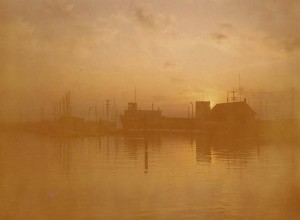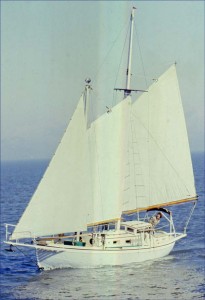Sailing the South San Francisco Bay
3. Hither, . . .
As indicated in the previous post, by the mid-seventies the refitting of the GAMBELLA was pretty much complete, and at that point we started sailing more while work tapered off somewhat. Initially, we poked into all the nooks and crannies of the South Bay. There are some interesting historical aspects to that general area, and also some sights that can only be appreciated or, at least, are best appreciated by boat. It should be noted, however, that getting to most of them requires close attention to the tides. Typically, an exploration must begin on a flood tide and end on an ebb tide. This will provide six to eight hours of sailing time. An alternative is to spend eight to twelve hours at the destination and return on the following tide. If you don’t follow this schedule you will probably end up stranded on the mud flats for hours. The tidal range in the South Bay is six to eight feet, about twice what it is at the Golden Gate Bridge. Consequently, at high tide there is plenty of water for sailing, whereas there are miles of mud flats at low tide. So, when studying the chart below, it should be noted that almost all of the area that is colored light green is sailable at high tide.
The earliest literary reference I have found to the South Bay is in the book, Two Years Before the Mast, by Richard Henry Dana. Dana was a student at Harvard when he contracted a severe case of measles which adversely effected his general health. His doctor recommended a sea voyage to aid his recovery. So Dana signed on as a deck hand in a vessel that was engaged in the hide trade up and down the coast of California. That was around the year 1835, and his written account of this experience was the only book available in English that contained detailed descriptions of California at the time of gold rush. Consequently, he became rather famous and there are many places in California that now bear the name of Dana as a result.
Dana’s book includes an account of rowing down the bay in long boats to the missions of San Jose and Santa Clara to collect hides. It is most likely that the route to Mission Santa Clara was by way of Guadalupe Slough and the way to Mission San Jose was Alviso Slough (see points 4 & 6 on chart below). In the late 1970s I was up Guadalupe slough several times as far as a small fuel dock used for unloading barges laden with jet fuel bound for Moffett Field Naval Air Station. It was a great place to watch an air show, and thus avoid the traffic and crowds. Also, if correctly timed with respect to the tides, you could occasionally leave Palo Alto on a flood tide, run down the bay and up Alviso Slough to the town of Alviso, have dinner at a fine Italian restaurant, sail back up the bay on an ebb tide, and be in your berth before you ran out of water.
(click on image for larger view)
Points of interest:
(1) Palo Alto Yacht Harbor
(2) Old location of the Palo Alto Boat Works
(3) New location of The Palo Alto Boat Works
(4) Guadalupe Slough
(5) Newark Slough
(6) Alviso Slough
(7) Oyster shed remains
(8) Abandoned duck club
In another historical reference to the South Bay, Jack London mentions “oyster pirates” in several of his fictional works. In the late 1800s large corporate interests were raising oysters in the South Bay. When harvested, the oysters were dredged up off bottom and stored temporarily in oyster sheds which were on pilings in the off shore shallow waters. The pirates would come down the bay on a flood tide at night, rob the sheds, and then retreat north on the ebb tide. A young Jack London apparently took part in this venture in a boat he owned called the RAZZLE DAZZLE. When I first started sailing on the the South Bay, circa 1960, some of the pilings that had supported these sheds were still visible at low tide (see point 7 on the chart above).
(click on images for larger view)
Palo Alto Yacht Harbor was always home base in those days (see point 1 on the chart above), but there were several nearby spots that were popular for overnight getaways. Almost directly across the bay were Newark Slough and Mowry Slough, both of which were near the Leslie Salt processing plant, but in spite of this they seemed very remote from civilization (see points 5 & 8 on chart above).
On one occasion I was up Mowry Slough by myself for an overnight, and an exploration of the abandoned duck club that is some distance up the slough. The Slough is quite narrow there so I put out anchors both fore and aft to keep the boat aligned with what water remained at low tide. In the morning as I was preparing to leave, I pulled up the forward anchor and then backed under power to lift the stern anchor, and in the process I backed over the stern anchor line and wound it around the prop. After saying a few naughty words under my breath I went forward and reset the bow anchor. After that I sat in the cockpit for a few moments trying to decide what to do.
Mowry Slough is so situated that going up the Slough is almost directly down wind and conversely coming out of the Slough is almost directly up wind. Getting out of there without power was a very daunting task, and it seemed apparent to me that I was going to need the engine. There was only one thing to do; I stripped down and went overboard to try and free the stern anchor line from the prop. The water was so muddy that I couldn’t see anything and had to do the whole operation with only my sense of touch. After coming up for air a few times I did mange to get the whole mess untangled. I climbed back aboard, cleaned up and started the engine. However, when I put her in gear nothing happened. This time I said the naughty words out loud. Apparently, this little mishap had broken the drive shaft. Again, I sat in the cockpit for a while trying to decide what to do next.
It seemed obvious that I was going to have to sail her out of there, but by now it was too late as the tide was already too far gone, making maneuvering in the slough impossible. That meant about another twelve hours while I waited for the next high tide. It gave me plenty of time to think about just how I would go about doing this. A gaff rigged schooner is quite a handful for a single person to handle under the best of conditions. There are three sails, five halyards and three sheets that have to be tended to, and on top of that, in this instance, I also had to raise the bow anchor at the same time I was getting underway. But I had twelve hours to plan my every move in detail.
I also had my art supplies with me so, to pass the time, I did an ink wash rendering of the abandoned duck club. The club house was abandoned in 1968 when legislation created the San Francisco Bay National Wildlife Refuge. You could wander through the collapsing shacks in the 1970s and still see clothes hanging on wall hooks and cans of food on the shelves. Swallows had moved in and made themselves at home and everything was covered with their droppings. You may see my rendering (as an etching) of that site by clicking here.
Come the next high tide I had all my moves thoroughly choreographed in my mind. I hoisted all the sails, raised the anchor, then dashed aft to man the tiller. I tacked a whole series of short reaches and I did manage to sail her out of there, cross the bay and and enter my own slip all under sail, a feat of seamanship I still feel rather proud of today.
Secure in my own home berth I decided to open up the engine room and crawl back there to see the extent of the bad news. To my surprise the shaft was not broken, it had simply been pulled out of the spline at the back of the transmission. It was a relatively easy thing to fix, one that could have been done on the spot had I not assumed the worst.
Categories
- THE GALLERY
- Uncle Rob's Art
- 3D Works (stills) I
- 3D Works (stills) II
- 3D Works (stills) III
- 3D Works (video)
- Design & Abstract I
- Design & Abstract II
- Design & Abstract III
- Figurative Works I
- Figurative Works II
- Landscapes I
- Landscapes II
- Largest Art Project
- Nautical and Marine Images (video)
- Nautical and Marine Images I
- Nautical and Marine Images II
- Nautical and Marine Images III
- Nautical and Marine Images IV
- Portraits
- Still Life Images
- Stump Hollow Photo Essay I
- Stump Hollow Photo Essay II
- Uncle Rob's Mendocino Shop
- The Five Sense Series
- Irene's Creations
- Works by Don Mason
- Works by Don Mason II
- Works by Joseph de Borde
- Painting by Albert Robbins
- Art by Leslie Masters Villani
- Paintings by Nellie Harriet Parker
- The Art of Bee Yearian
- Works by Evie Wilson
- Uncle Rob's Art
- SCHOONER MOON BOOKS
- SEA STORIES
- ONE DOZEN AND TWO ESSAYS
- Cousinhood
- Art by Definition
- Cake Mixed Economy
- Marriage Anyone?
- Sex and/or Violence
- Searching for Truth
- The Philosophical Roots of Science
- Stepping Stones and Stumbling Blocks
- On Being Good
- Teaching By Example
- The Basic Law of Civilization
- Where Goeth Evil?
- A Modern Empircal "Religion"
- Knowledge as Wealth
- PAPERS AND ARTICLES
- FAMILY STORIES
- BOOK REVIEWS
Archive
- December 2021
- October 2020
- June 2020
- September 2019
- July 2017
- March 2017
- December 2016
- November 2016
- October 2016
- August 2016
- July 2016
- June 2016
- May 2016
- March 2016
- February 2016
- February 2015
- January 2015
- February 2014
- December 2013
- November 2013
- August 2013
- June 2013
- August 2012
- July 2012
- April 2012
- March 2012
- February 2012
- November 2011
- September 2011
- June 2011
- May 2011
- April 2011
- March 2011
- February 2011
- January 2011
- December 2010
- November 2010
- October 2010
- September 2010
- August 2010
- July 2010
- June 2010
- May 2010
- April 2010
- March 2010
- February 2010
- January 2010
- December 2009
- November 2009
- October 2009
- September 2009
- August 2009
- July 2009
- June 2009
- May 2009
- April 2009
- March 2009
- February 2009
- January 2009
- December 2008
- November 2008
- October 2008
- September 2008



